Effect of Dispersing Multiwalled Carbon Nanotubes and Graphene Nanoplatelets Hybrids in the Matrix on the Flexural Fatigue Properties of Carbon/Epoxy Composites
Abstract
:1. Introduction
2. Materials and Methods
2.1. Materials
2.2. Nano-Modified Epoxy Resins
2.3. Fabrication of Nano-Modified Cf/Ep Laminates
2.4. Tests of Mechanical Properties
3. Results and Discussion
3.1. Monotonic Flexural Properties
3.2. Fatigue Flexural Properties
3.3. Observation of Fracture Surfaces
4. Conclusions
- Adding individual type of nanofiller can improve the monotonic properties of the Cf/Ep laminates. The laminate specimen with matrix modified under a MWCNT:GNP ratio of 9:1 displays higher flexural modulus and strength than the ones with individual type of nanofiller and the hybrid ones with other nanofiller ratios. MWCNT
- The MWCNTs present better performance in improving the fatigue strength of Cf/Ep laminates than the GNPs. The hybrid nano-Cf/Ep laminates with matrix modified under a MWCNT:GNP ratio of 9:1 demonstrates better synergistic effect on the fatigue strength than those modified under other nanofiller ratios.
- The addition of small amounts of GNPs in the MWCNT-modified polymer matrix can provide larger surface areas for crosslink between the nanoparticles and the polymer matrix. Moreover, the MWCNTs can separate GNPs effectively to avoid the agglomeration of GNPs and constitute the networks between the GNPs for load transfer, further improve the monotonic and fatigue properties of the Cf/Ep laminates.
- The utilized synergistic index is a tool with high discrimination to evaluate the synergistic effect of hybrid nanoparticles on the studied mechanical properties.
- The flexural endurance limits of the studied nano-modified Cf/Ep laminates increase with the monotonic strengths.
- The pullout effect of MWCNTs and the crack deflection effect of GNPs are the main reinforcement mechanisms to improve the fatigue strength of the Cf/Ep laminates. The bridging effects of the nanoparticles at the matrix crack sites and fiber/matrix interfaces provide another toughening mechanism to resist the damage development.
Author Contributions
Funding
Institutional Review Board Statement
Informed Consent Statement
Data Availability Statement
Conflicts of Interest
References
- Mouritz, A.P.; Bannister, M.K.; Falzon, P.J.; Leong, K.H. Review of applications for advanced three-dimensional fibre textile composites. Compos. Part A-Appl. S. Manuf. 1999, 30, 1445–1461. [Google Scholar] [CrossRef]
- Jauhari, N.; Mishra, R.; Thakur, H. Natural fibre reinforced composite laminates—A review. Mater Today-Proc. 2015, 2, 2868–2877. [Google Scholar] [CrossRef]
- Dransfield, K.; Baillie, C.; Mai, Y.W. Improving the delamination resistance of CFRP by stitching—A review. Compos. Sci. Technol. 1994, 50, 305–317. [Google Scholar] [CrossRef]
- Bilisik, K. Three-dimensional braiding for composites: A review. Text. Res. J. 2013, 83, 1414–1436. [Google Scholar] [CrossRef]
- Zhou, G.; Xie, G.; Bao, X. Mechanical behavior of advanced nano-laminates embedded with carbon nanotubes—A review. Int. J. Smart Nano Mater. 2010, 1, 136–171. [Google Scholar] [CrossRef]
- Tang, Y.; Ye, L.; Zhang, Z.; Friedrich, K. Interlaminar fracture toughness and CAI strength of fibre-reinforced composites with nanoparticles–A review. Compos. Sci. Technol. 2013, 86, 26–37. [Google Scholar] [CrossRef]
- Manjunatha, C.M.; Chandra, A.A.; Jagannathan, N. Fracture and fatigue behavior of polymer nanocomposites—A review. J. Indian I Sci. A-Eng. 2015, 95, 249–266. [Google Scholar]
- De Cicco, D.; Asaee, Z.; Taheri, F. Use of nanoparticles for enhancing the interlaminar properties of fiber-reinforced composites and adhesively bonded joints—A review. Nanomaterials 2017, 7, 360. [Google Scholar] [CrossRef] [Green Version]
- Di Boon, Y.; Joshi, S.C. A review of methods for improving interlaminar interfaces and fracture toughness of laminated composites. Mater. Today Commun. 2020, 22, 100830. [Google Scholar] [CrossRef]
- Bansal, T.; Malik, S.; Batra, T.; Shah, M.; Gupta, A.; Khan, K.L.A. Review of effect of nanofillers on FRP composites. In Recent Advances in Mechanical Engineering; Kumar, A., Pal, A., Kachhwaha, S.S., Jain, P.K., Eds.; Springer: Singapore, 2021; pp. 411–417. [Google Scholar]
- Li, J.; Zhang, Z.; Fu, J.; Liang, Z.; Ramakrishnan, K.R. Mechanical properties and structural health monitoring performance of carbon nanotube-modified FRP composites: A review. Nanotechnol. Rev. 2021, 10, 1438–1468. [Google Scholar] [CrossRef]
- Yadav, A.; Godara, R.K.; Bhardwaj, G.; Patil, R.U.; Singh, S.K.; Khanna, K. A Review on Fracture Analysis of CNT/Graphene Reinforced Composites for Structural Applications. Arch. Comput. Method Eng. 2021, 28, 1–38. [Google Scholar] [CrossRef]
- Grimmer, C.S.; Dharan, C.K.H. High-cycle fatigue of hybrid carbon nanotube/glass fiber/polymer composites. J. Mater. Sci. 2008, 43, 4487–4492. [Google Scholar] [CrossRef]
- Böger, L.; Sumfleth, J.; Hedemann, H.; Schulte, K. Improvement of fatigue life by incorporation of nanoparticles in glass fibre reinforced epoxy. Compos. Part A-Appl. S. Manuf. 2010, 41, 1419–1424. [Google Scholar] [CrossRef]
- Kostopoulos, V.; Baltopoulos, A.; Karapappas, P.; Vavouliotis, A.; Paipetis, A. Impact and after-impact properties of carbon fibre reinforced composites enhanced with multi-wall carbon nanotubes. Compos. Sci. Technol. 2010, 70, 553–563. [Google Scholar] [CrossRef]
- Vavouliotis, A.; Paipetis, A.; Kostopoulos, V. On the fatigue life prediction of CFRP laminates using the electrical resistance change method. Compos. Sci. Technol. 2011, 71, 630–642. [Google Scholar] [CrossRef] [Green Version]
- Takeda, T.; Fan, W.; Feng, Q.P.; Fu, S.Y.; Narita, F.; Shindo, Y. Cryogenic mechanical properties of woven glass/epoxy composites modified with multi-walled carbon nanotube and n-butyl glycidyl ether under tensile static and cyclic loadings. Cryogenics 2013, 58, 33–37. [Google Scholar] [CrossRef]
- Gude, M.; Hufenbach, W.; Koch, I.; Koschichow, R.; Schulte, K.; Knoll, J. Fatigue testing of carbon fibre reinforced polymers under VHCF loading. Procedia Mater. Sci. 2013, 2, 18–24. [Google Scholar] [CrossRef] [Green Version]
- Borrego, L.P.; Costa, J.D.M.; Ferreira, J.A.M.; Silva, H. Fatigue behaviour of glass fibre reinforced epoxy composites enhanced with nanoparticles. Compos. Part B-Eng. 2014, 62, 65–72. [Google Scholar] [CrossRef]
- Knoll, J.B.; Riecken, B.T.; Kosmann, N.; Chandrasekaran, S.; Schulte, K.; Fiedler, B. The effect of carbon nanoparticles on the fatigue performance of carbon fibre reinforced epoxy. Compos. Part A-Appl. S. Manuf. 2014, 67, 233–240. [Google Scholar] [CrossRef]
- Bourchak, M.; Algarni, A.; Khan, A.; Khashaba, U. Effect of SWCNTs and graphene on the fatigue behavior of antisymmetric GFRP laminate. Compos. Sci. Technol. 2018, 167, 164–173. [Google Scholar] [CrossRef]
- Grimmer, C.S.; Dharan, C.K.H. Enhancement of delamination fatigue resistance in carbon nanotube reinforced glass fiber/polymer composites. Compos. Sci. Technol. 2010, 70, 901–908. [Google Scholar] [CrossRef]
- Fenner, J.S.; Daniel, I.M. Hybrid nanoreinforced carbon/epoxy composites for enhanced damage tolerance and fatigue life. Compos. Part A-Appl. S. Manuf. 2014, 65, 47–56. [Google Scholar] [CrossRef]
- Kadlec, M.; Nováková, L.; Mlch, I.; Guadagno, L. Fatigue delamination of a carbon fabric/epoxy laminate with carbon nanotubes. Compos. Sci. Technol. 2016, 131, 32–39. [Google Scholar] [CrossRef]
- Yavari, F.; Rafiee, M.A.; Rafiee, J.; Yu, Z.Z.; Koratkar, N. Dramatic increase in fatigue life in hierarchical graphene composites. ACS Appl. Mater. Interfaces 2010, 2, 2738–2743. [Google Scholar] [CrossRef] [Green Version]
- Shen, M.Y.; Chang, T.Y.; Hsieh, T.H.; Li, Y.L.; Chiang, C.L.; Yang, H.; Yip, M.C. Mechanical properties and tensile fatigue of graphene nanoplatelets reinforced polymer nanocomposites. J. Nanomater. 2013, 2013, 565401. [Google Scholar] [CrossRef]
- Leopold, C.; Just, G.; Koch, I.; Schetle, A.; Kosmann, J.B.; Gude, M.; Fiedler, B. Damage mechanisms of tailored few-layer graphene modified CFEP cross-ply laminates. Compos. Part A-Appl. S. Manuf. 2019, 117, 332–344. [Google Scholar] [CrossRef]
- Tareq, M.S.; Jony, B.; Zainuddin, S.; Al Ahsan, M.; Hosur, M.V. Fatigue analysis and fracture toughness of graphene reinforced carbon fibre polymer composites. Fatigue Fract. Eng. Mater. 2021, 44, 461–474. [Google Scholar] [CrossRef]
- Hood, M.A.; Mari, M.; Muñoz-Espí, R. Synthetic strategies in the preparation of polymer/inorganic hybrid nanoparticles. Materials 2014, 7, 4057–4087. [Google Scholar] [CrossRef]
- Koilraj, T.T.; Kalaichelvan, K. Hybrid Nanocomposites–A Review. In Applied Mechanics and Materials; Trans Tech Publications: Baech, Switzerland, 2015; Volume 766, pp. 50–56. [Google Scholar]
- Kumar, G.N.; Kumar, C.S.; Rao, G.S. An experimental investigation on mechanical properties of hybrid polymer nanocomposites. Mater Today-Proc. 2019, 19, 691–699. [Google Scholar] [CrossRef]
- Kumar, A.; Sharma, K.; Dixit, A.R. A review of the mechanical and thermal properties of graphene and its hybrid polymer nanocomposites for structural applications. J. Mater. Sci. 2019, 54, 5992–6026. [Google Scholar] [CrossRef]
- de Oliveira, M.M.; Forsberg, S.; Selegård, L.; Carastan, D.J. The Influence of Sonication Processing Conditions on Electrical and Mechanical Properties of Single and Hybrid Epoxy Nanocomposites Filled with Carbon Nanoparticles. Polymers 2021, 13, 4128. [Google Scholar] [CrossRef]
- Kumar, A.; Sharma, K.; Dixit, A.R. A review on the mechanical properties of polymer composites reinforced by carbon nanotubes and graphene. Carbon Lett. 2021, 31, 149–165. [Google Scholar] [CrossRef]
- Aziz, S.S.A.; Abulkhair, H.; Moustafa, E.B. Role of hybrid nanoparticles on thermal, electrical conductivity, microstructure, and hardness behavior of nanocomposite matrix. J. Mater. Res. Technol. 2021, 13, 1275–1284. [Google Scholar] [CrossRef]
- He, Y.; Chen, G.; Zhang, L.; Sang, Y.; Lu, C.; Yao, D.; Zhang, Y. Role of functionalized multiwalled carbon nanotubes on mechanical properties of epoxy-based composites at cryogenic temperature. High Perform. Polym. 2014, 26, 922–934. [Google Scholar] [CrossRef]
- Wang, P.N.; Hsieh, T.H.; Chiang, C.L.; Shen, M.Y. Synergetic effects of mechanical properties on graphene nanoplatelet and multiwalled carbon nanotube hybrids reinforced epoxy/carbon fiber composites. J. Nanomater. 2015, 2015, 838032. [Google Scholar] [CrossRef]
- Chiou, Y.C.; Chou, H.Y.; Shen, M.Y. Effects of adding graphene nanoplatelets and nanocarbon aerogels to epoxy resins and their carbon fiber composites. Mater. Design 2019, 178, 107869. [Google Scholar] [CrossRef]
- Atif, M.; Afzaal, I.; Naseer, H.; Abrar, M.; Bongiovanni, R. Surface modification of carbon nanotubes: A tool to control electrochemical performance. ECS J. Solid State Sc. 2020, 9, 041009. [Google Scholar] [CrossRef]
- ASTM International. Standard Test Methods for Flexural Properties of Unreinforced and Reinforced Plastics and Electrical Insulating Materials; D790-17; ASTM International: West Conshohocken, PA, USA, 2017; Available online: https://www.astm.org/d0790-17.html (accessed on 5 December 2021).
- Cecen, V.; Seki, Y.; Sarikanat, M.; Tavman, I.H. FTIR and SEM analysis of polyester-and epoxy-based composites manufactured by VARTM process. J. Appl. Polym. Sci. 2008, 10, 2163–2170. [Google Scholar] [CrossRef]
- González, M.G.; Cabanelas, J.C.; Baselga, J. Applications of FTIR on epoxy resins-identification, monitoring the curing process, phase separation and water uptake. In Infrared Spectroscopy-Materials Science, Engineering and Technology; Theophanides, T., Ed.; IntechOpen: London, UK, 2012; Volume 2, pp. 261–284. [Google Scholar]
- ASTM International. Standard Test Method for Flexural Fatigue Properties of Plastics; D7774-17; ASTM International: West Conshohocken, PA, USA, 2017; Available online: https://www.astm.org/d7774-17.html (accessed on 5 December 2021).
- Jen, Y.M.; Huang, J.C.; Zheng, K.Y. Synergistic effect of multi-walled carbon nanotubes and graphene nanoplatelets on the monotonic and fatigue properties of uncracked and cracked epoxy Composites. Polymers 2020, 12, 1895. [Google Scholar] [CrossRef]
- Jen, Y.M.; Chang, H.H.; Lu, C.M.; Liang, S.Y. Temperature-dependent synergistic effect of multi-walled carbon nanotubes and graphene nanoplatelets on the tensile quasi-Static and fatigue properties of epoxy nanocomposites. Polymers 2021, 13, 84. [Google Scholar] [CrossRef]
- Szeluga, U.; Kumanek, B.; Trzebicka, B. Synergy in hybrid polymer/nanocarbon composites. A review. Compos. Part A-Appl. S. Manuf. 2015, 73, 204–231. [Google Scholar] [CrossRef]
- Ghaleb, Z.A.; Mariatti, M.; Ariff, Z.M. Synergy effects of graphene and multiwalled carbon nanotubes hybrid system on properties of epoxy nanocomposites. J. Reinf. Plast. Compos. 2017, 36, 685–695. [Google Scholar] [CrossRef]
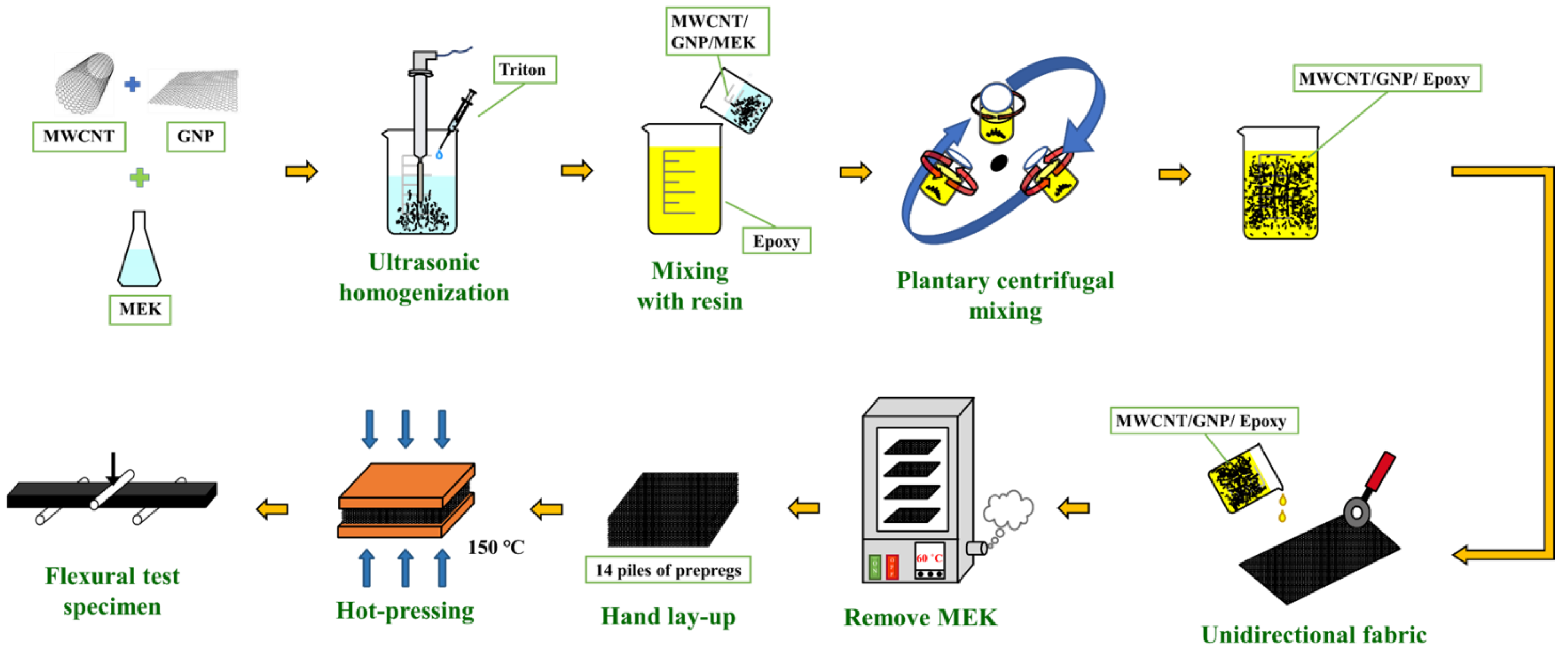

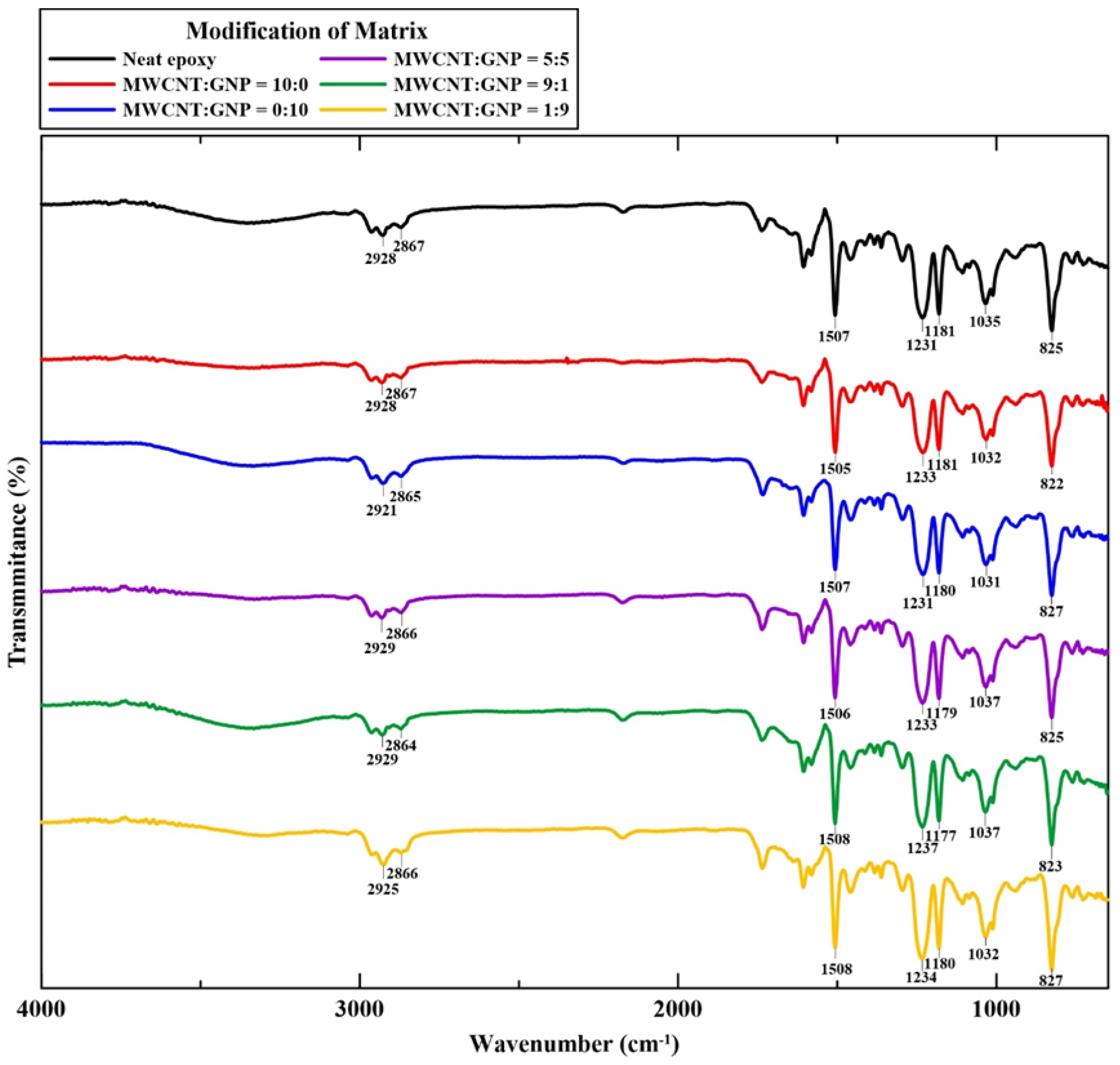
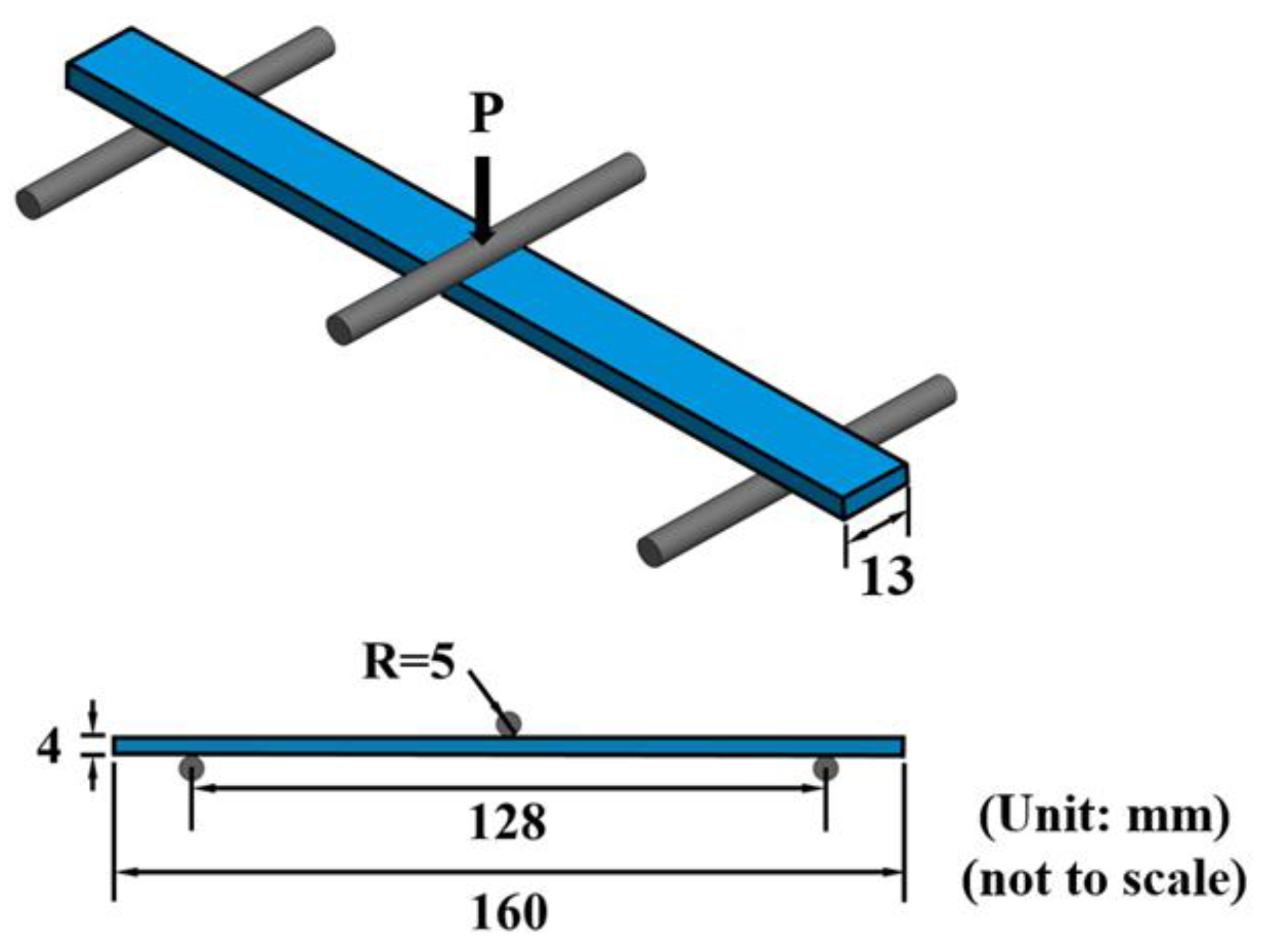
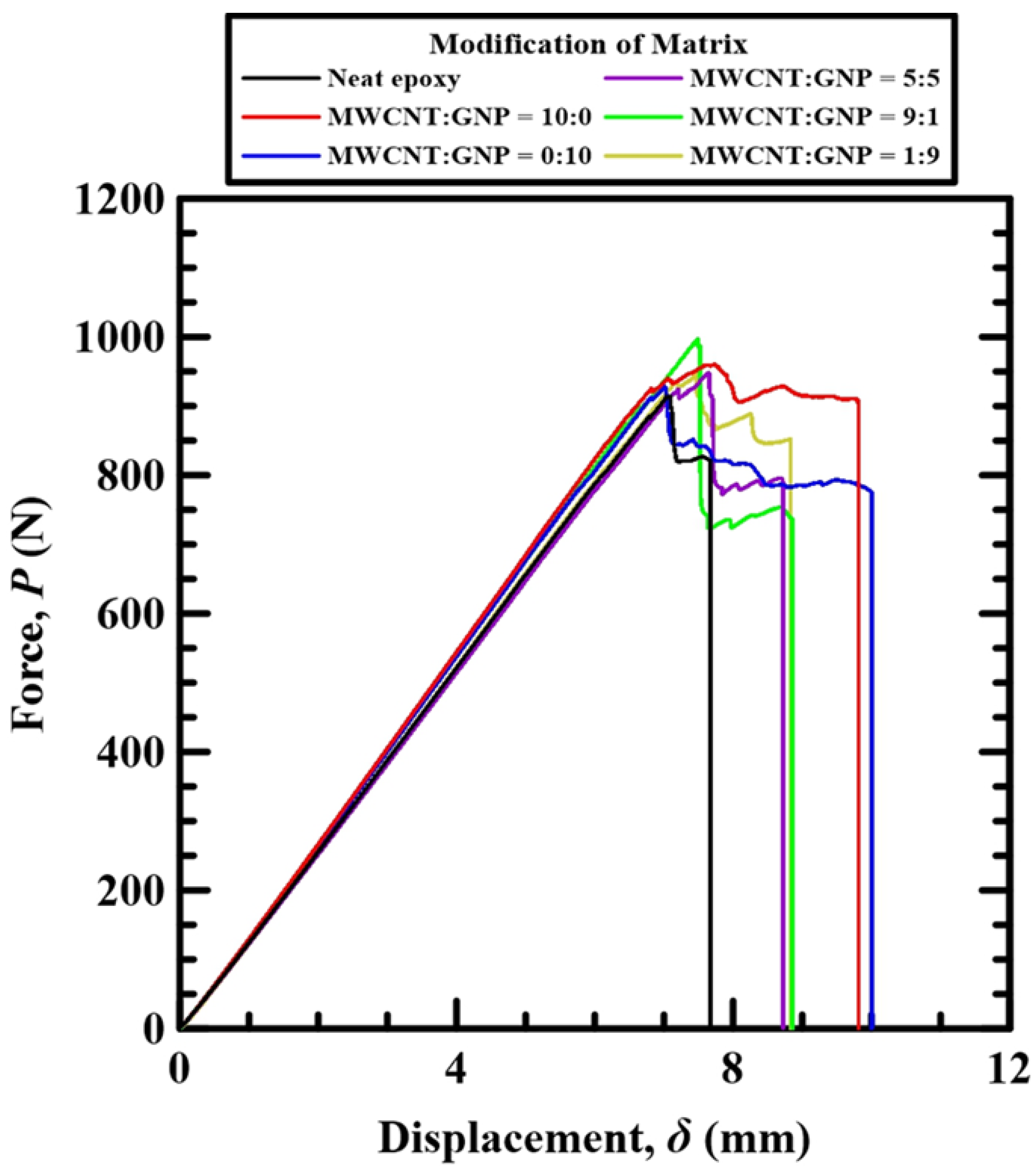
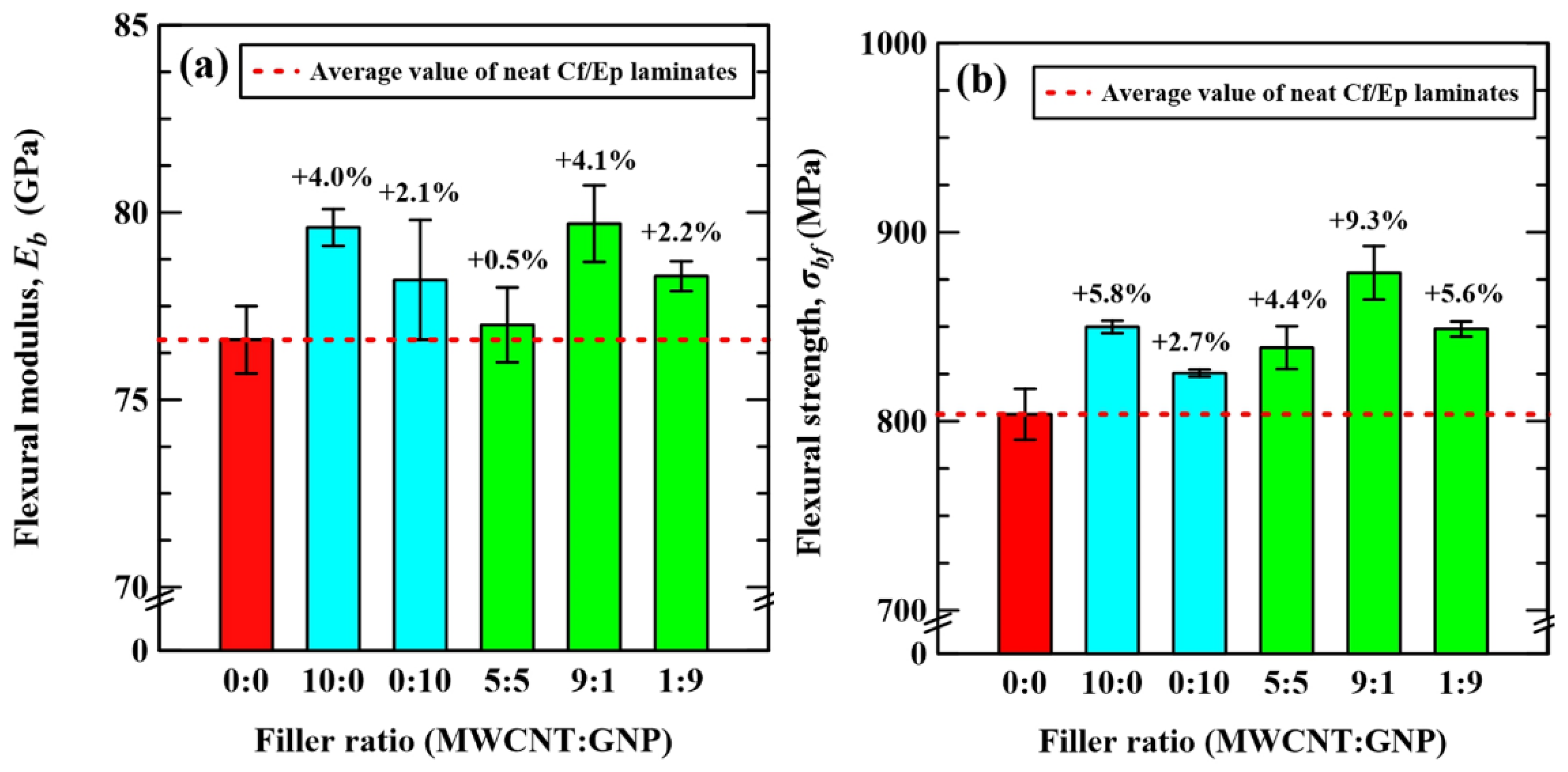
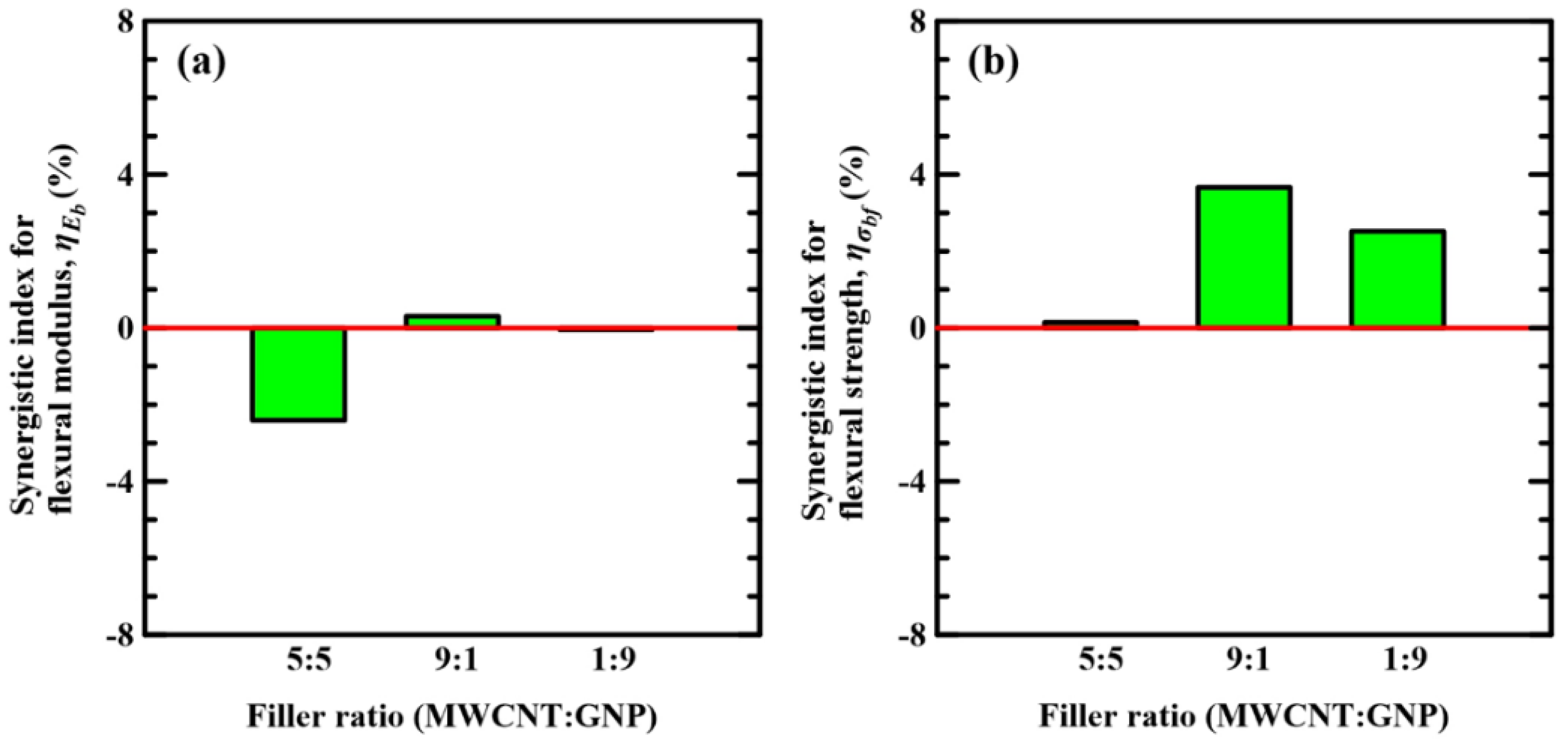


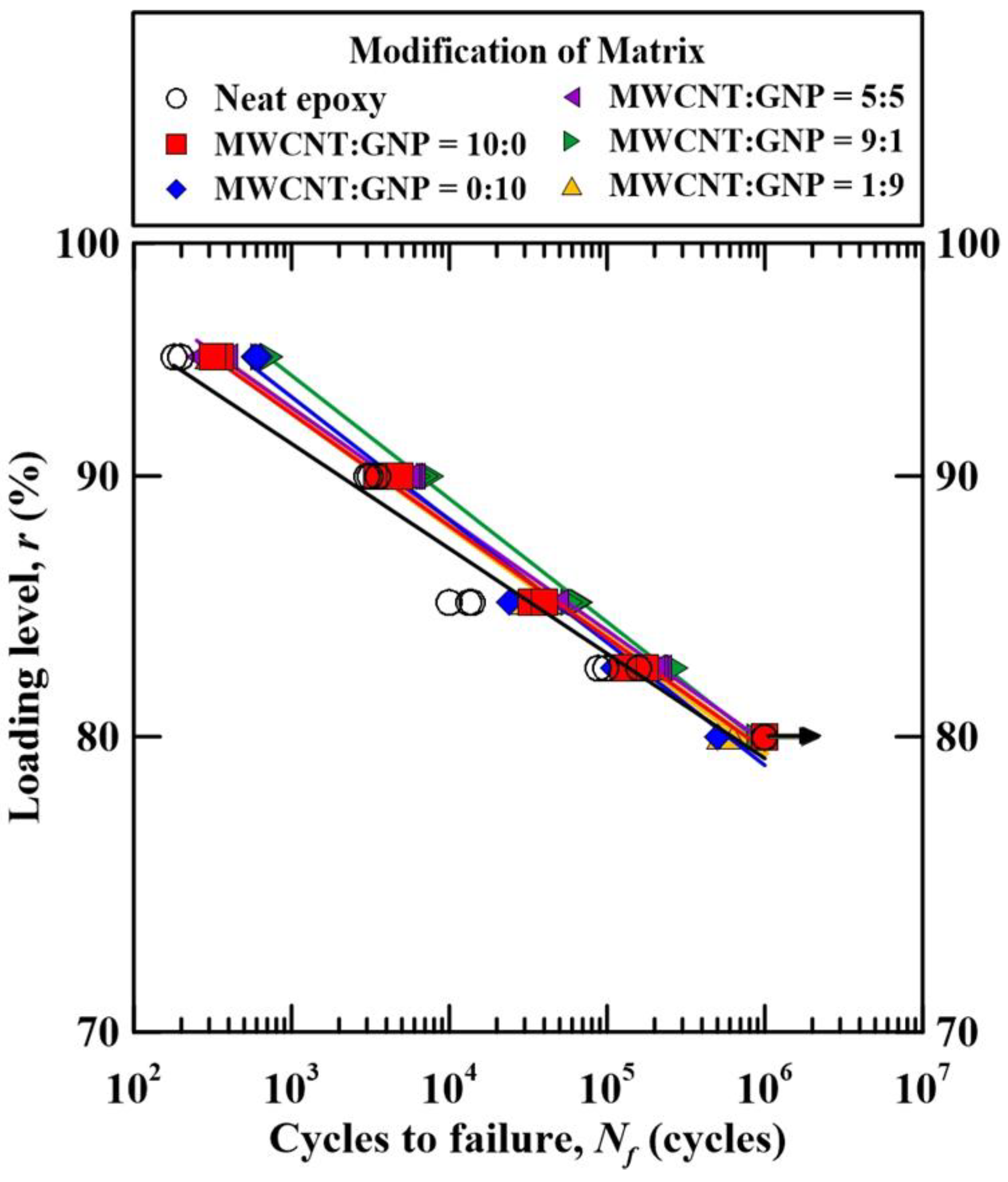
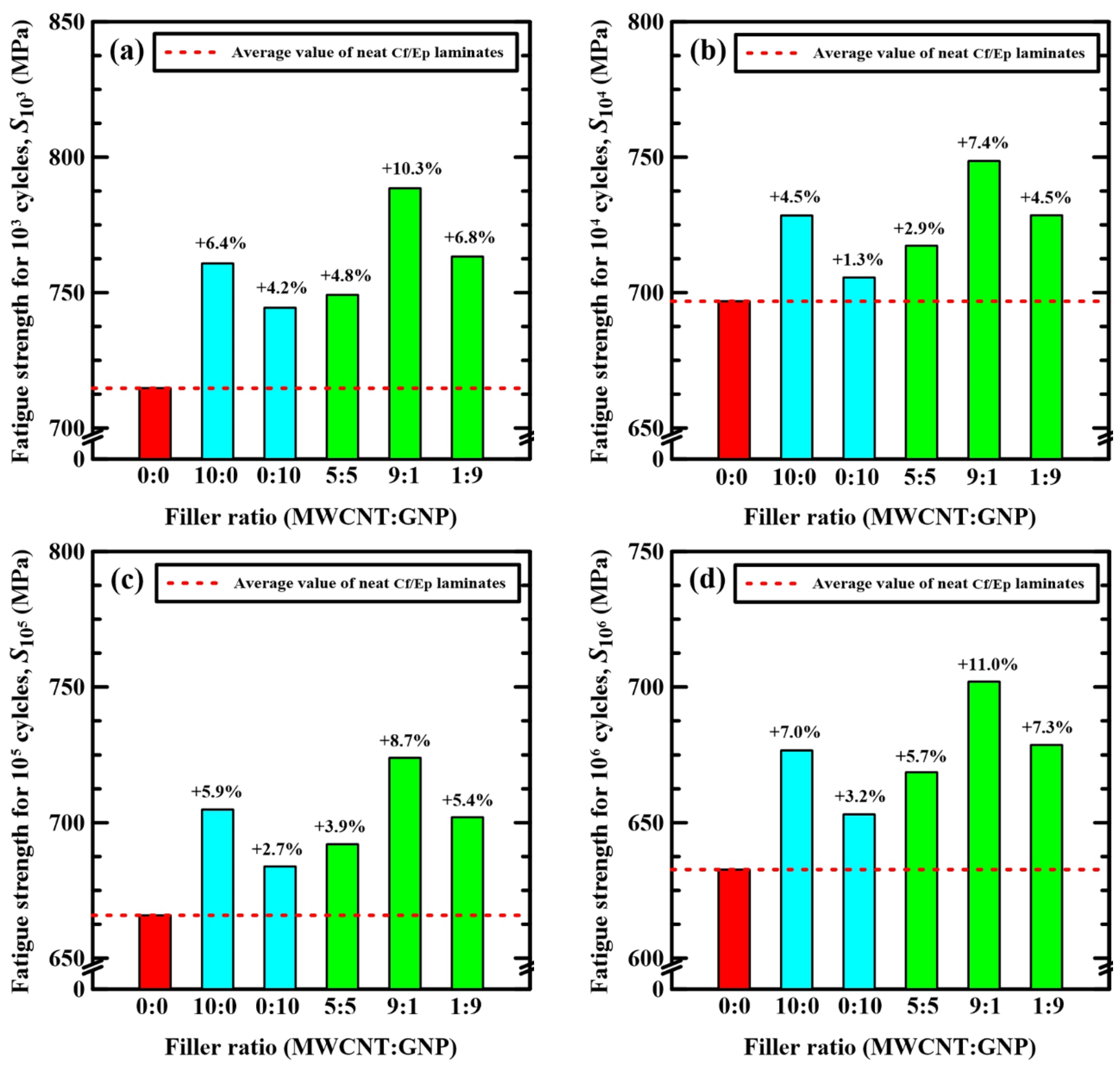
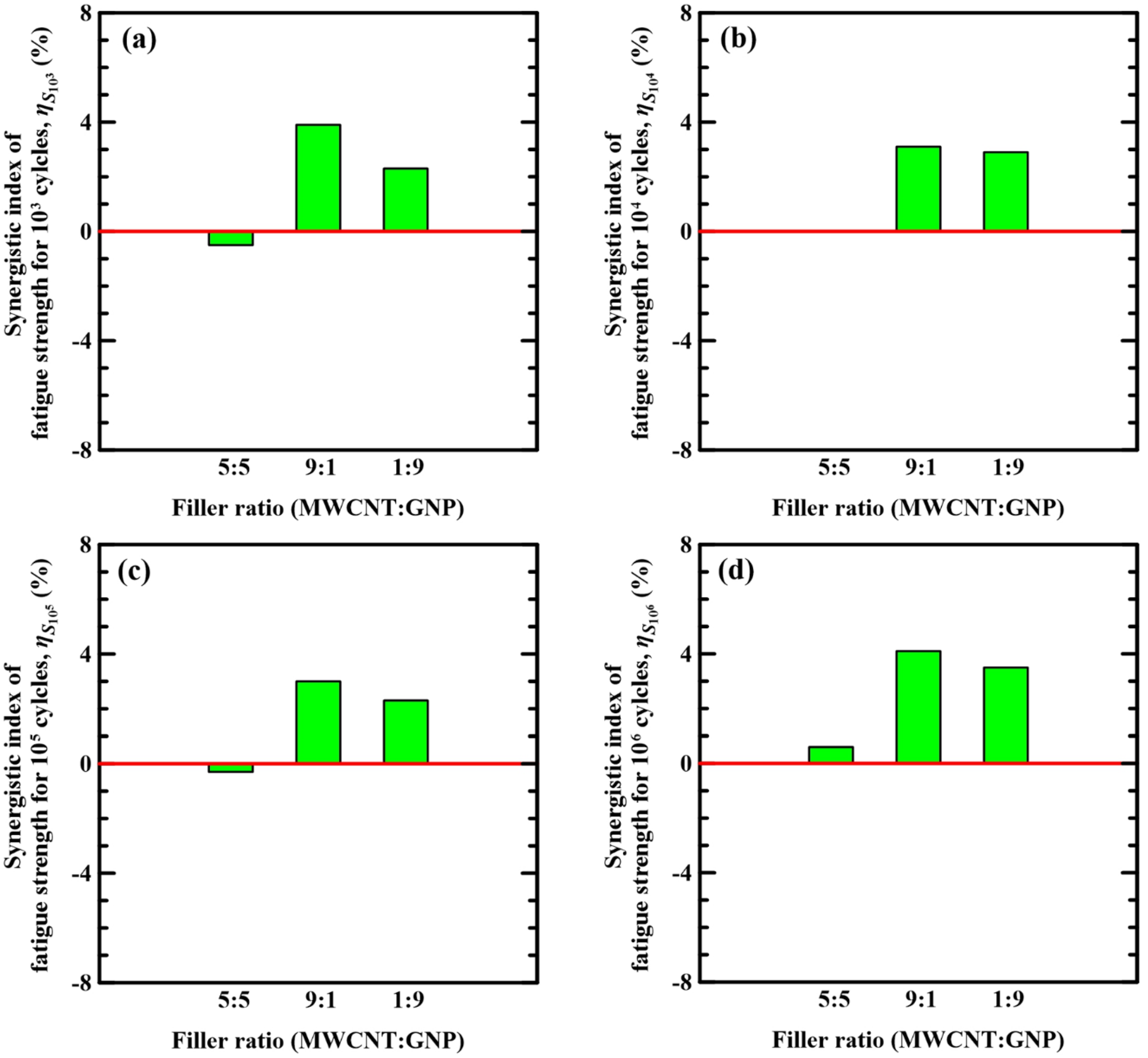


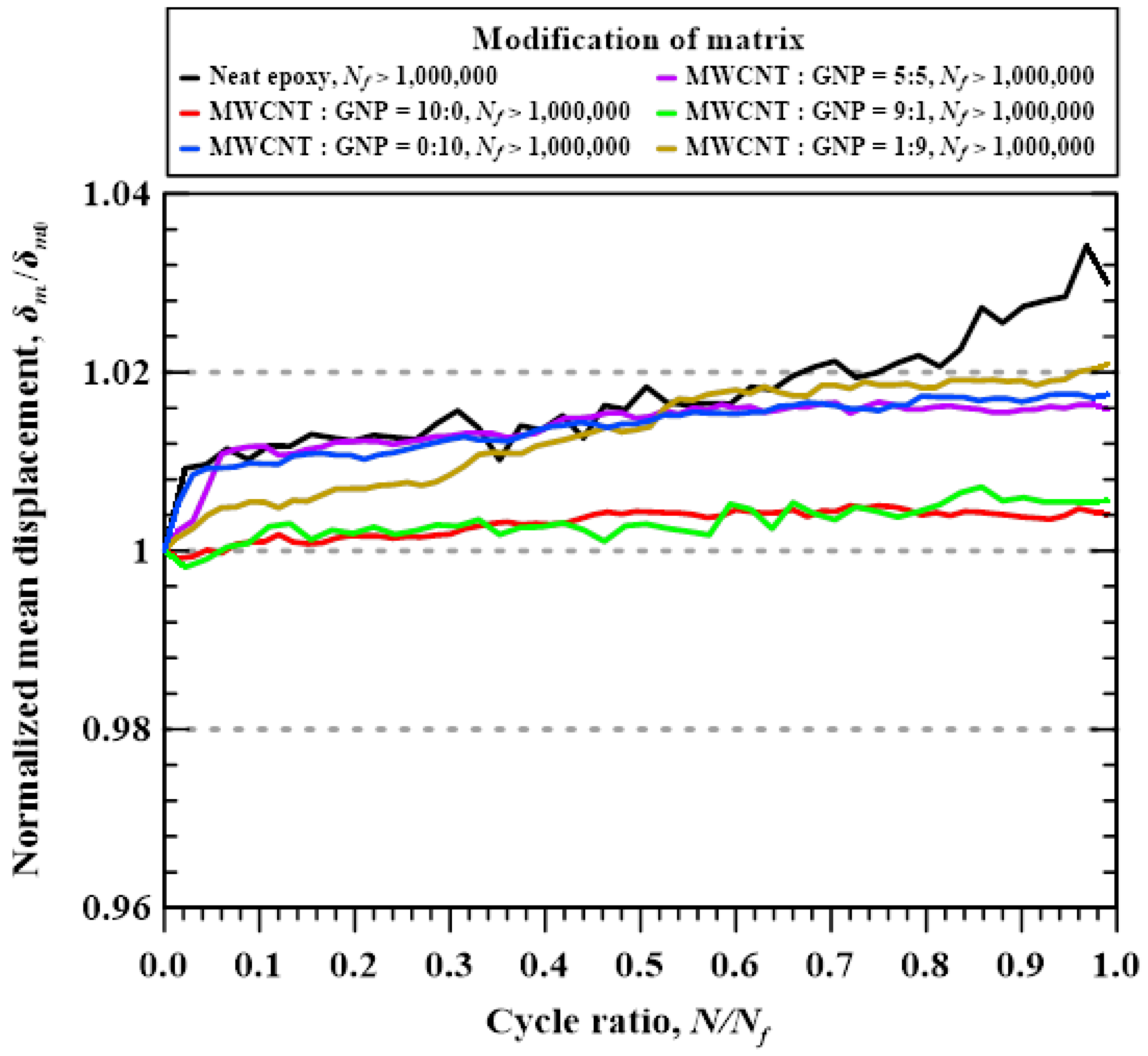


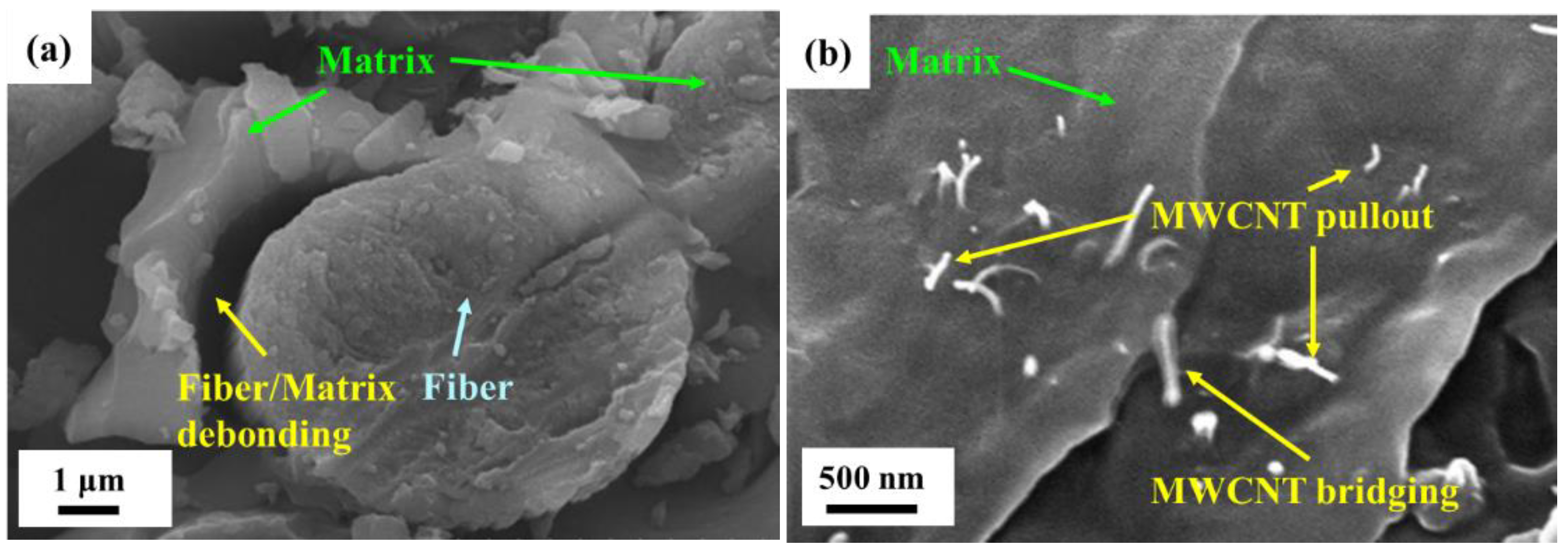
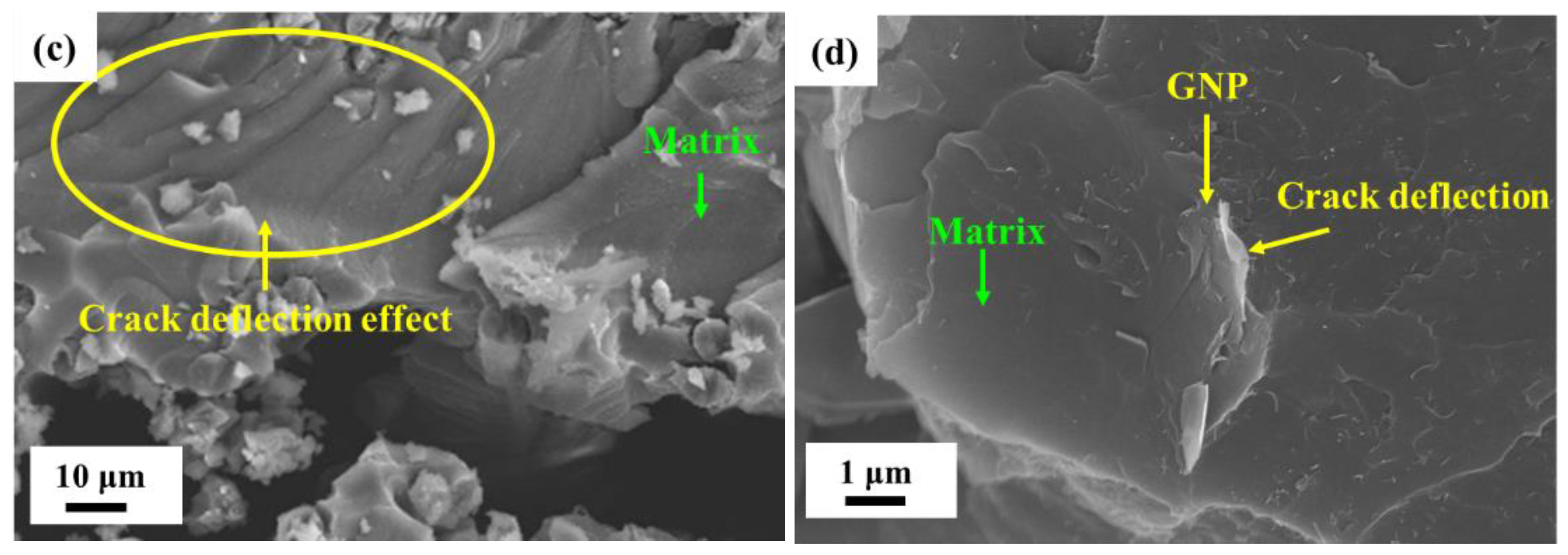
| Reinforcement | Matrix | Nanofillers | |
|---|---|---|---|
| Carbon Fabric | Epoxy | MWCNT | GNP |
| Fiber count in tow: 12 K Areal weight: 216 g/m2 Thickness: 0.28 mm | Bisphenol A type Epoxy resin: dicyanamide curing agent = 18:2 Solid content: 60% Curing temperature: 125–150 °C Viscosity: 24 mpa·s | Diameter: ~9.5 nm Length: ~1.5 μm Purity: >90% | Diameter: ~5 µm Thickness: ~10 nm Purity: >99.5% |
| Nanofiller Ratios MWCNT:GNP | Flexural Modulus Eb (GPa) | Flexural Strength σbf (MPa) |
|---|---|---|
| 0:0 | 76.57 ± 0.85 | 803.7 ± 13.5 |
| 10:0 | 79.64 ± 0.46 | 849.9 ± 3.3 |
| 0:10 | 78.16 ± 1.61 | 825.5 ± 1.9 |
| 5:5 | 76.98 ± 1.05 | 839.9 ± 11.3 |
| 9:1 | 79.70 ± 0.96 | 878.5 ± 14.2 |
| 1:9 | 78.29 ± 0.40 | 848.8 ± 4.0 |
| Nanofiller Ratio MWCNT:GNP | Loading Level r (%) | Fatigue Life Nf (Cycles) | Fatigue Strength Coefficient A | Fatigue Strength Exponent B | Coefficient of Determination R2 |
|---|---|---|---|---|---|
| 0:0 | 80 | >1,000,000, >1,000,000, >1,000,000 | 845.6 | −0.021 | 0.96 |
| 82.5 | 98,449, 157,430, 87,937 | ||||
| 85 | 13,858, 10,041, 13,245 | ||||
| 90 | 3002, 3152, 3548 | ||||
| 95 | 200, 179, 197 | ||||
| 10:0 | 80 | >1,000,000, >1,000,000, >1,000,000 | 917.0 | −0.022 | 0.99 |
| 82.5 | 156,454, 175,215, 125,986 | ||||
| 85 | 35,017, 33,285, 40,137 | ||||
| 90 | 4863, 3468, 4862 | ||||
| 95 | 313, 354, 314 | ||||
| 0:10 | 80 | 1,000,000, 1,000,000, 500,484 | 909.8 | −0.024 | 0.98 |
| 82.5 | 156,606, 109,653, 146,599 | ||||
| 85 | 39,818, 23,845, 40,339 | ||||
| 90 | 4034, 4269, 4475 | ||||
| 95 | 622, 580, 600 | ||||
| 5:5 | 80 | >1,000,000, >1,000,000, >1,000,000 | 906.1 | −0.022 | 0.99 |
| 82.5 | 218,020, 208,795, 197,017 | ||||
| 85 | 48,388, 40,896, 32,602 | ||||
| 90 | 6015, 5683, 5503 | ||||
| 95 | 390, 250, 360 | ||||
| 9:1 | 80 | >1,000,000, >1,000,000, 899,403 | 977.9 | −0.024 | 0.99 |
| 82.5 | 229,099, 275,826, 127,150 | ||||
| 85 | 68,521, 66,892, 60,159 | ||||
| 90 | 7848, 7260, 6432 | ||||
| 95 | 752, 646, 751 | ||||
| 1:9 | 80 | 518,803, >1,000,000, 625,264 | 919.6 | −0.022 | 0.99 |
| 82.5 | 213,637, 210,586, 220,651 | ||||
| 85 | 39,594, 28,953, 41,634 | ||||
| 90 | 5680, 4064, 4752 | ||||
| 95 | 295, 362, 301 |
Publisher’s Note: MDPI stays neutral with regard to jurisdictional claims in published maps and institutional affiliations. |
© 2022 by the authors. Licensee MDPI, Basel, Switzerland. This article is an open access article distributed under the terms and conditions of the Creative Commons Attribution (CC BY) license (https://creativecommons.org/licenses/by/4.0/).
Share and Cite
Jen, Y.-M.; Ni, W.-L. Effect of Dispersing Multiwalled Carbon Nanotubes and Graphene Nanoplatelets Hybrids in the Matrix on the Flexural Fatigue Properties of Carbon/Epoxy Composites. Polymers 2022, 14, 918. https://doi.org/10.3390/polym14050918
Jen Y-M, Ni W-L. Effect of Dispersing Multiwalled Carbon Nanotubes and Graphene Nanoplatelets Hybrids in the Matrix on the Flexural Fatigue Properties of Carbon/Epoxy Composites. Polymers. 2022; 14(5):918. https://doi.org/10.3390/polym14050918
Chicago/Turabian StyleJen, Yi-Ming, and Wei-Lun Ni. 2022. "Effect of Dispersing Multiwalled Carbon Nanotubes and Graphene Nanoplatelets Hybrids in the Matrix on the Flexural Fatigue Properties of Carbon/Epoxy Composites" Polymers 14, no. 5: 918. https://doi.org/10.3390/polym14050918





